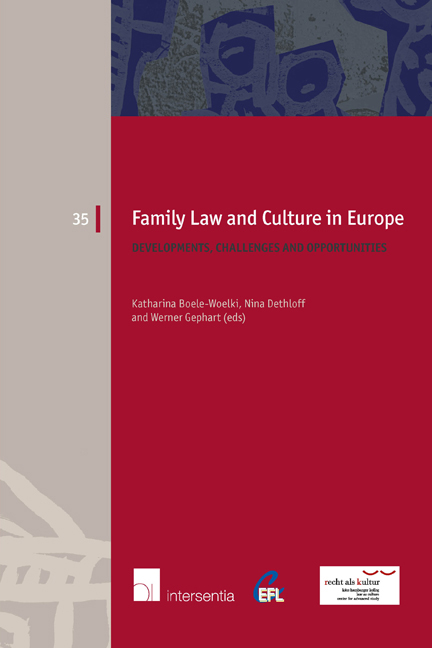Book contents
- Frontmatter
- Preface
- Contents
- List of Authors
- PART ONE THE CEFL PRINCIPLES ON PROPERTY RELATIONS BETWEEN SPOUSES
- PART TWO BREAKUP OF (NON-)FORMALISED RELATIONSHIPS
- PART THREE NEW CONCEPTS OF PARENTAGE
- The Right of the Child to Parents
- Contracting on Parentage
- Biological and Social Parenthood
- France: Biological and Social Parentage
- Anonymous Relinquishment and Baby-Boxes: Life-Saving Mechanisms or a Violation of Human Rights?
- Cross-Border Surrogacy: Time for a Convention?
- Re-Thinking Family Law: A New Legal Paradigm for Stepfamilies?
- PART FOUR INTERNATIONAL FAMILY RELATIONSHIPS
- PART FIVE TRANSNATIONAL FAMILIES: ACROSS NATIONS AND CULTURES
- EUROPEAN FAMILY LAW SERIES
Contracting on Parentage
from PART THREE - NEW CONCEPTS OF PARENTAGE
Published online by Cambridge University Press: 22 November 2017
- Frontmatter
- Preface
- Contents
- List of Authors
- PART ONE THE CEFL PRINCIPLES ON PROPERTY RELATIONS BETWEEN SPOUSES
- PART TWO BREAKUP OF (NON-)FORMALISED RELATIONSHIPS
- PART THREE NEW CONCEPTS OF PARENTAGE
- The Right of the Child to Parents
- Contracting on Parentage
- Biological and Social Parenthood
- France: Biological and Social Parentage
- Anonymous Relinquishment and Baby-Boxes: Life-Saving Mechanisms or a Violation of Human Rights?
- Cross-Border Surrogacy: Time for a Convention?
- Re-Thinking Family Law: A New Legal Paradigm for Stepfamilies?
- PART FOUR INTERNATIONAL FAMILY RELATIONSHIPS
- PART FIVE TRANSNATIONAL FAMILIES: ACROSS NATIONS AND CULTURES
- EUROPEAN FAMILY LAW SERIES
Summary
INTRODUCTION
Since ancient times, the establishment of legal parentage has followed the child's genetic and biological origins based on the idea that the natural parents are both willing and obliged to take care of the child. However, until recently it was impossible to scientifically prove the genetic relationship between a child and his or her presumptive parents. Therefore, legally assigning a child to parents – especially to a father – could only be executed through fictions or legal presumptions. The Roman law principle of pateris est quem nuptiae demonstrant (the father is he whom the marriage points out) is well known. The possibility that legal and genetic paternity might not coincide could obviously not be excluded.
As for the mother, for a long time the maxim mater sempercerta (the mother is always certain) was considered valid. The woman who had given birth to the child was regarded as the child's mother. She was also without doubt the child's genetic mother.
Now, times have changed. Today it is possible to establish genetic relationships beyond doubt. However, medical progress and social change in recent decades have begun to question the concept of parentage based on genetic descent. Not only has modern reproductive medicine increased the number of children who are not genetically related to one or to both of their legal parents (such as in the case of heterologous insemination or surrogacy), it is also no longer a matter of course that children are raised by their married, genetic parents. Children frequently live in step-families where the new partner of one of the parents shares custody of the child.
Due to the developments outlined above, doctrine has called for social parenthood to be given more weight. In practice, more and more people are attempting to establish parentage through contractual agreements. Such agreements accompany medically-assisted forms of reproduction in particular. However, the legality and desirability of agreements which pertain to key aspects of parentage is even being discussed outside the realm of modern reproductive medicine, not only in areas such as maintenance agreements but also in the field of the derivative acquisition of parental custody.
- Type
- Chapter
- Information
- Family Law and Culture in EuropeDevelopments, Challenges and Opportunities, pp. 151 - 168Publisher: IntersentiaPrint publication year: 2014



